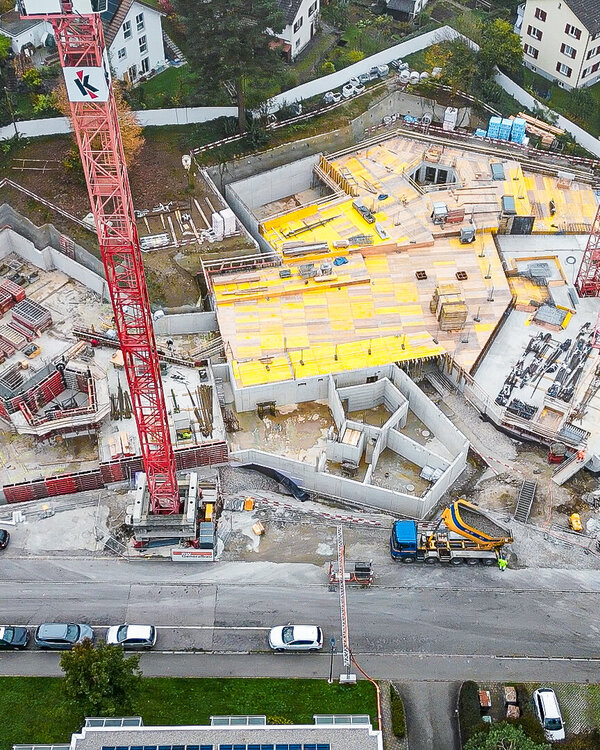Real Estate Funds: The Market Outlook for 2025
The Swiss construction industry and real estate funds are benefiting from falling interest rates. Rising prices for residential properties are expected – what this means for real estate investments is explained by Stephan Lüthi in the interview.

How do you, as a real estate investor, view the year 2025?
Stephan Lüthi: With great confidence. The Swiss real estate sector is currently benefiting from strong monetary tailwinds. The key interest rates were cut by 125 basis points to 0.5% in 2024, and further rate cuts are likely this year. While there is a tendency towards tighter lending conditions, refinancing costs have developed favourably. A lot of money is currently flowing back into the Swiss real estate market. This is evident from the volume of successful capital raisings for real estate products, which approached the record level before the interest rate reversal last year with over four billion Swiss francs. Listed real estate funds showed strong performance over the past 12 months, with an average premium of around XY% over net asset value at year-end, underscoring the attractiveness of the asset class. In 2025, institutional investors are unlikely to be able to avoid Swiss real estate.
Stephan Lüthi, Head of Real Estate
Stephan Lüthi has been head of the Real Estate division at Asset Management of Zürcher Kantonalbank since 2014 and is responsible for the real estate investments of Swisscanto in this role. Before joining Swisscanto in 2014, he headed construction and facility management at Wincasa and was a member of the executive board. Stephan Lüthi studied architecture, holds a Master of Science in Real Estate (CUREM), and completed a postgraduate degree in business administration.

Are widespread real estate revaluations to be expected again?
In the residential segment and prime commercial properties, market-wide revaluations in the low single digits are the most likely scenario for 2025. On the one hand, lower key interest rates are likely to manifest in lower discount rates. On the other hand, these segments are particularly popular with investors in the transaction market. At the same time, the supply of attractive investment opportunities is limited. Accordingly, transaction prices are likely to rise again in the coming months, and the acquisition yields that have increased since 2022 will decline significantly. A reduction in the reference interest rate for residential properties will have a dampening effect on value development. Whether riskier real estate sectors will also experience value growth depends on further interest rate cuts and the risk appetite of market participants.
Is there a threat of a return to zero or even negative interest rates?
Money should cost something. An appropriate price tag for loans is a valuable disciplining and steering instrument for sensibly balanced investment activity. Cheap money, on the other hand, leads to misincentives, increased risk-taking, and excesses that can lead to distortions in the investment and real estate markets in the medium term. We have seen this again in this cycle. Many international real estate markets with higher leverage ratios experienced significant corrections in the double-digit percentage range during the interest rate reversal. The consequences were sometimes spectacular bankruptcies, whether in Germany, the USA, or China, particularly among developers and construction companies that had accumulated immense debts with free money.
What are the prospects for the rental market?
The robust rental market has been the great support for Swiss real estate investments in recent years. In the housing market, there is now a nationwide housing shortage. This is unlikely to change significantly in the foreseeable future given the low construction volumes and continued high immigration. Asking rents in the residential segment will therefore continue to rise. However, there could be some relief in existing rents. The reference interest rate is likely to fall at least once next year, from 1.75 to 1.50 percent. This would correspond to a rent reduction of around four percent.
And what are the forecasts for commercial real estate?
Demand for commercial space depends primarily on economic prospects, which seem quite stable in Switzerland. The current vacancy situation in the major segments of office, retail, and commercial is also manageable. In the city centres of Zurich and Geneva, there are currently hardly any larger vacant office spaces available for rent. Outside the city centres, the office situation is more competitive. Larger vacancies are usually limited to specific submarkets or individual properties.
How will the situation in the construction industry develop?
In general, there is much to suggest a high construction volume in the coming years. This is because immigration pressure is unlikely to decrease significantly. Switzerland ranks high in terms of quality of life, stability, and as a business location. That is why Switzerland is heading for a population of 10 million. Given these trends, accelerating residential construction is desirable and economically attractive, but implementation is fraught with obstacles.
You are referring to the density of regulations.
Yes, lengthy approval processes and excessive appeals as a tactic to prevent construction are undoubtedly high obstacles for urban residential construction. On the positive side, the acute housing shortage is leading to more intense political discussion of the issue. Many political forces are seeking solutions to speed up approval processes and intensify residential construction. The peak of spatial planning regulation is likely to have been reached. The problem of insufficient residential construction can only be sustainably solved by expanding supply. This requires incentive systems instead of bans. It is also important to promote residential construction by public bodies, cooperatives, and private developers alike. Central to this is densification in urban settlement areas to prevent urban sprawl.
Where are the sustainability trends heading?
The orientation phase is coming to an end, and the industry has agreed on basic concepts. Now it is a matter of refining, consolidating, and establishing transparent industry standards to ensure the comparability of different investment products. Significant progress has been made in recent years in reporting environmental metrics for climate neutrality, up to and including auditability. However, there is still little coordination on CO2 reduction pathways. But there are also efforts to establish a certain industry-wide standardisation and thus comparability. In addition to topics such as measuring Scope 3 emissions, physical risks at the property level, and water use efficiency, cost efficiency is increasingly coming into focus. The use of intelligent automation and openness to technical innovations is intended to accelerate the achievement of sustainability goals at the same cost.


